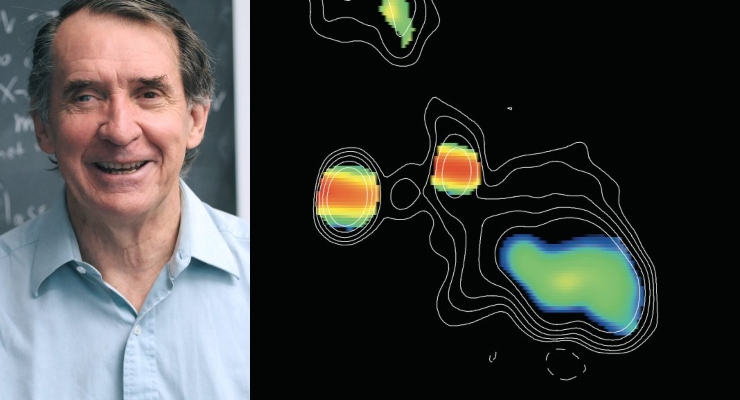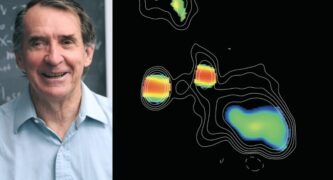
Tony Readhead [Photo credit: CALTECH]
New research by a Caltech-led team of researchers is shedding light on the enigmatic behavior of supermassive black holes at the hearts of galaxies known as Compact Symmetric Objects (CSOs). These objects have challenged astronomers for decades, initially thought to be simply young versions of familiar active galaxies. But a recent investigation led by Catech’s Robinson Professor of Astronomy, Emeritus Anthony Readhead paints a different picture.
“These CSOs are not young,” explains Readhead. “You wouldn’t call a 12-year-old dog young even though it has lived a shorter life than an adult human. These objects are a distinct species all of their own that live and die out in thousands of years rather than the millions of years that are common in galaxies with bigger jets.”
The California Institute of Technology research, published in a series of three papers in The Astrophysical Journal, upends previous assumptions about CSOs.
Utilizing data from the National Radio Astronomy Observatory’s Very Long Baseline Array, the team meticulously reviewed observations of over 3,000 CSO candidates, ultimately verifying 64 and identifying an additional 15. These observations hold the key to unlocking the secrets of CSOs.
“The Very Long Baseline Array observations are the most detailed in astronomy, providing images with details equivalent to measuring the width of a human hair at a distance of 100 miles,” says Readhead.
The team’s analysis reveals a critical difference between CSOs and other active galaxies: the lifespan of their jets. CSOs expel powerful jets for a mere 5,000 years before abruptly shutting down. “The CSO jets are very energetic jets but they seem to shut off,” says co-author Vikram Ravi. “The jets stop flowing from the source.”
The cause of these short-lived bursts of activity seems to lie in a dramatic cosmic event – a tidal disruption event (TDE). When a star wanders too close to a supermassive black hole, it gets ripped apart by the immense gravitational forces. Readhead believes this shredded stellar feast is the fuel source for the CSO’s fiery jets.
“We think that a single star gets ripped apart, and then all that energy is channeled into jets along the axis the black hole is spinning around,” explains Readhead. “The giant black hole starts out invisible to us, and then when it consumes a star, boom! The black hole has fuel, and we can see it.”
This theory, first proposed by Readhead in the 1990s, gained traction as the team meticulously combed through existing data and identified a distinct population of CSOs. Unlike their longer-lived counterparts, like the jets of Cygnus A which stretch for hundreds of thousands of light-years, CSO jets are much more compact, extending outward only about 1,500 light-years at most.
The research also suggests that the size of the devoured star plays a role in the duration of the jet activity. “The TDEs we’ve previously seen only lasted for a few years,” says Ravi. “We think that the remarkable TDEs powering CSOs last far longer because the disrupted stars are very large in size, very massive, or both.”
By analyzing the radio images of CSOs, researchers can almost trace their evolution, like looking at snapshots of a black hole’s life. Younger CSOs exhibit shorter jets, while older objects have jets that extend further. The team estimates that a lucky few, about 1%, might even transition into long-lived giants like Cygnus A, likely fueled by the chaotic mergers of galaxies.
These findings hold significant weight for our understanding of black holes. CSOs offer a unique window into how these enigmatic giants interact with their stellar neighbors. The research opens the door to a whole new “laboratory” for studying black holes, allowing scientists to observe them on timescales of years and decades, rather than millions of years. This deeper look promises to reveal even more surprising discoveries about the universe’s most fascinating objects.














 9 comments
9 comments


